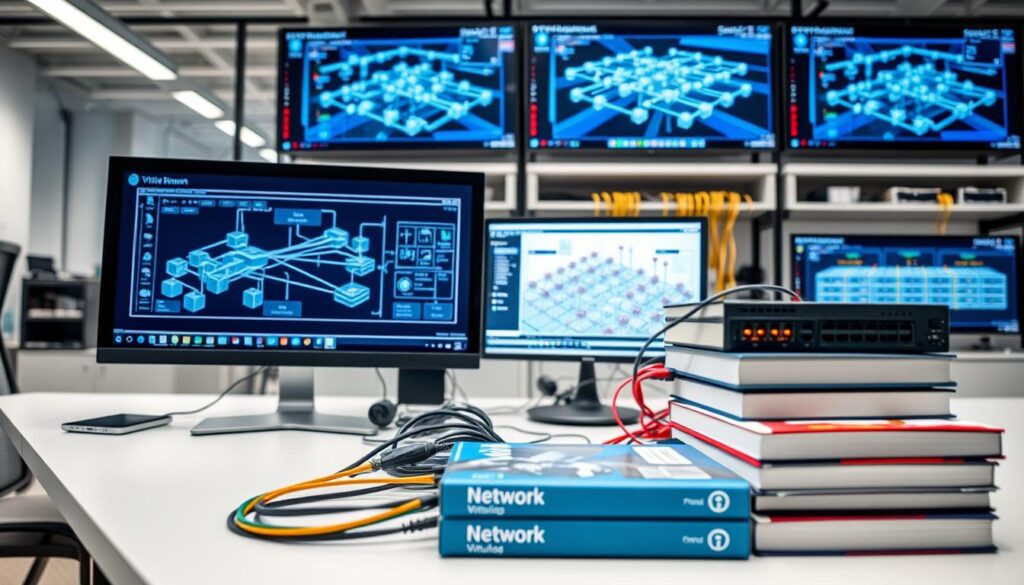Did you know that using virtualization can cut operational costs by up to 30%? This shows how powerful CCNA Network Virtualization is today. It helps businesses deal with complex networks better and keeps them safe.
Network virtualization is more than a trend. It’s a key strategy for managing IT resources. It lets you set up virtual servers, storage, and networks without extra hardware. This saves money and makes IT more flexible and efficient.
In this guide, you’ll learn about network virtualization certification and best practices. You’ll also see the latest from Cisco. Get ready to see how virtual technologies are essential for businesses to thrive in today’s fast-changing world.
Understanding Network Virtualization
Network virtualization changes how companies manage their network resources. It combines hardware and software into one unit. This lets many virtual networks work together without changing the physical setup.
This technology is key for meeting today’s networking needs.
Definition of Network Virtualization
Network virtualization creates virtual versions of network parts like routers and switches. These virtual parts work together on one physical device. This setup lets each part manage its own traffic, like Virtual Routing and Forwarding (VRF).
Virtual machines are a common example. They let many operating systems run on one machine. This shows how virtualization works.
Importance in Modern Networking
Network virtualization is very important today. It makes networks more efficient and uses resources better. This means fewer physical devices are needed, saving money on space and cooling.
It also makes security easier. With network virtualization, you can set up many virtual firewalls. This boosts security in Local Area Networks (LANs).
Network virtualization helps companies quickly set up new network services. It makes it easier to move workloads based on device capacity. This makes resources more flexible and efficient.
It also helps with disaster recovery. It makes it faster to recover sensitive data.
Core Benefits of Data Center Network Virtualization
Data center network virtualization offers many benefits. It changes how we network. You can see better performance and work more efficiently.
Increased Efficiency
One big plus is the efficiency gains. Virtualization makes using resources better. You can set up apps quickly without buying too much stuff.
This cuts down on waste and makes things run smoother. It also helps manage networks better. This makes your network work well and be easy to handle.
Cost Savings
Virtualization also means cost-effective networking solutions. You can run many virtual servers on one machine. This saves a lot of money on both costs and what you spend upfront.
This is key for businesses wanting to save money but keep output high.
Scalability and Flexibility
Virtual networks are great for growing and changing. You can add or take away resources as needed. This makes it easy to adapt without big changes.
They’re also good for testing and production. This makes them very flexible for businesses that need to change fast.
| Benefit | Description | Impact |
|---|---|---|
| Increased Efficiency | Optimized resource utilization and agile application provisioning. | Higher performance with reduced redundancy. |
| Cost Savings | Reduction in capital expenditures through effective hardware utilization. | Lower operational costs leading to better budget allocation. |
| Scalability | Simple addition or removal of resources based on demand. | Enhanced ability to grow and adapt. |
| Flexibility | Virtual environments for various purposes, including testing. | Quick adaptation to business changes. |
CCNA Network Virtualization Training Resources
Getting the right knowledge for CCNA NV training is key. The field is moving fast with software-defined networking and virtual tech. Good training resources can really help you understand and do well on the CCNA NV exam.
Finding Online Courses
Many online platforms have courses for CCNA NV. Look for ones that mix theory and practical labs. This way, you get to try out what you learn.
- Interactive sessions that focus on core networking concepts.
- Opportunities to practice with virtual labs.
- Access to a community of learners for discussion and support.
Find a course that fits your learning style and pace. Make sure it covers important topics like VLANs, OSPF, and IPv6. Cisco Networking Academy and Udemy often have good courses.
Recommended Study Guides
Study guides can also help a lot. Look for materials like:
- Official Certification Guide – Covers all exam topics in detail.
- Practice Tests – Helps assess your readiness for the exam.
- Video Tutorials – Useful for visual learners who benefit from demonstration.
Good study guides help you learn key topics step by step. Make sure to practice and revise before the exam. This will help you feel more ready.

| Resource Type | Description | Why It’s Beneficial |
|---|---|---|
| Online Course | Interactive training with hands-on labs | Gains practical experience and theoretical knowledge |
| Official Study Guide | Comprehensive resource covering exam objectives | Aligns study efforts with certification requirements |
| Practice Exam | Simulates the exam environment | Builds confidence and identifies knowledge gaps |
| Video Tutorials | Visual aids and explanations for complex topics | Enhances understanding through demonstrations |
Implementing Network Virtualization Best Practices
When you start using virtualization in your company, it’s key to follow the best steps. First, check your current setup to see what works well and what doesn’t. Then, create network designs that fit your business needs, making sure you use resources wisely. Tools for integration are very helpful, helping you set up your virtual network smoothly.
Assessing Current Infrastructure
Before you dive into virtualization, it’s important to look at your current network. You should think about:
- Network topology
- Hardware compatibility
- Bandwidth needs
- Security rules
This check helps you know where virtualization will make the biggest difference, making the change easier.
Designing Virtualized Network Layouts
Creating good virtual network designs is important for growth and flexibility. Consider these points:
- Modularity: A setup that makes it easy to update.
- Consolidation: Combining functions to use less hardware.
- Performance optimization: Giving the right resources to important apps.
These ideas help your network work better and be ready for changes in your business.
Integrating Technologies for Efficient Deployment
Using tools like Cisco’s SDN solutions can make setting up your network easier. Cisco ACI, for example, helps your network grow with more traffic and devices. It’s also important to have strong security, including:
- Access controls
- Firewalls
- Intrusion detection systems
- Encryption protocols
Testing in a safe place helps avoid problems and makes sure your virtual setup works well.

Common Challenges in Network Virtualization
Network virtualization brings many benefits but also faces big challenges. These challenges need to be understood and managed well. We will look at two main issues: security and managing network complexity.
Security Concerns
Security is a big challenge in network virtualization. Hypervisors and virtualization systems can have vulnerabilities. This can put the whole network at risk.
When many virtual machines share a server, the risk grows up to 40%. It’s important to use strong security measures. This helps keep data and resources safe.
Managing Network Complexity
Managing complex networks is key in virtualization. With Network Functions Virtualization (NFV), networks get more complicated. You need skills in software, virtualization, and network management.
Tools that help manage complexity are vital. They help keep things running smoothly. Studies show a 35% increase in management work in virtual settings.
Using automated tools and segmentation can help tackle these challenges. Solutions that make the most of resources and simplify monitoring are important. They help keep performance high and costs low.
| Challenge | Details | Potential Solutions |
|---|---|---|
| Security Concerns | Increased vulnerability exposure, risk of data breaches. | Implement advanced security protocols, conduct regular security assessments, use dedicated security tools. |
| Managing Network Complexity | Higher management overhead, need for specialized skills. | Adopt automated management solutions, use effective monitoring tools to streamline processes. |
With the right planning and tools, organizations can handle network virtualization’s challenges. They can also address security concerns effectively.
Cisco’s Network Virtualization Solutions
Cisco leads in network virtualization, setting high standards in the field. It combines advanced virtualization with its products, making networks more flexible and efficient. This includes powerful hardware like Cisco Nexus switches and cloud integration, helping businesses quickly meet new demands.
Overview of Cisco Technologies
Cisco uses models like Infrastructure as a Service (IaaS) and Software as a Service (SaaS) for virtualization. IaaS lets businesses rent network devices, reducing the need for on-site IT. Cloud services also cut IT costs by 20-30%, saving on equipment and energy.
Cisco’s Virtual Routing and Forwarding (VRF) technology is a key example of its innovation. It lets routers act as multiple isolated routers, improving resource use.
Comparative Advantages
Using Cisco network solutions brings many benefits, including:
- Enhanced scalability: Virtualization lets you run many OS instances on one server, using hardware better.
- Increased server uptime: Servers can run almost non-stop, boosting disaster recovery.
- Efficiency improvement: Some setups see a 80% utilization rate, much higher than traditional systems.
Certification Pathways: Cisco CCNA NV
The CCNA NV certification prepares network pros for advanced virtualization roles. It focuses on practical skills with virtualization, key for exam success. Knowing Cisco’s virtualization concepts well and having hands-on experience is vital.
Candidates get detailed study guides and chances for real-world practice. This helps them master the necessary topics.
| Feature | Cisco Network Solutions |
|---|---|
| Technology Type | Virtualization Technologies (IaaS, SaaS) |
| Efficiency Improvement | Up to 80% resource utilization |
| Server Uptime | Up to 99.99% |
| Cost Reduction | 20-30% in equipment and energy expenses |
| Scalability | Multiple OS instances on a single server |
Conclusion
The CCNA Network Virtualization guide has shown us how virtual technologies change networking today. It’s clear that knowing network basics well is key for success in this field. By understanding these concepts, you can make smart choices about using virtualization.
Using network virtualization makes things more efficient and saves money. It also helps businesses grow by adapting quickly to new needs. Many companies have seen big improvements in how fast they work and how much they spend.
To do network virtualization well, you need to keep learning and be proactive. By using the tools and methods from this guide, you and your team can do great in the digital world. This will help you use network virtualization to its fullest.
Source Links
- Cisco Data Center Network Virtualization Fundamentals – Secure Tech Institute
- Enterprise Campus Network Virtualization > CCDE Study Guide: Enterprise Campus Architecture Design
- Network Virtualization and Virtualizing Network Devices – Study CCNA
- Virtualization Fundamentals in CCNA – GeeksforGeeks
- Data Center Virtualization Fundamentals: Understanding Techniques and Designs for Highly Efficient Data Centers with Cisco Nexus, UCS, MDS, and Beyond, Rough Cuts
- The Role of CCNA in Cloud Networking and Virtualization
- Implementing and Administering Cisco Solutions (CCNA)
- CCNA Certification Training
- Courses for Cisco Certified Network Associate (CCNA) 200-301: Cisco Certified Network Associate (CCNA) – Skillsoft
- Best Practices for Implementing Cisco’s SDN Solutions
- The Role of Network Administrators in Implementing Network Virtualization
- Network Functions Virtualization (NFV) Implementation Challenges – GeeksforGeeks
- 8.3 Benefits and Challenges of Virtualization
- 13.6.3 Module Quiz – Network Virtualization (Answers)
- Virtualization concepts to study for CCNP and CCIE exams | TechTarget
- CCNA certification prep: Network fundamentals [updated 2020]
- What is Network Virtualization? – GeeksforGeeks





